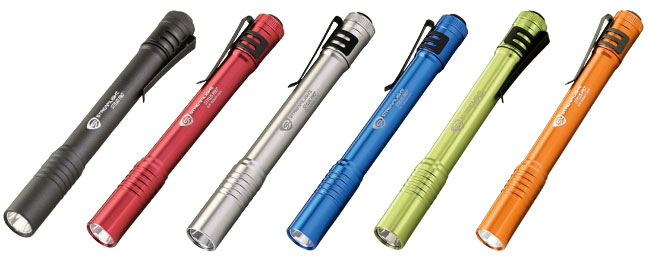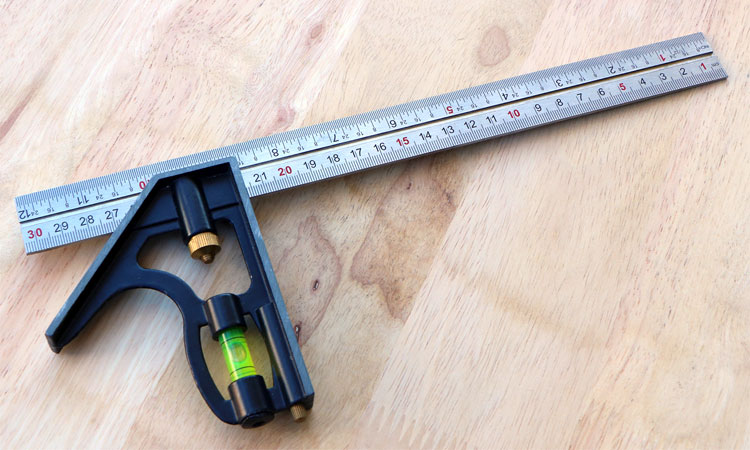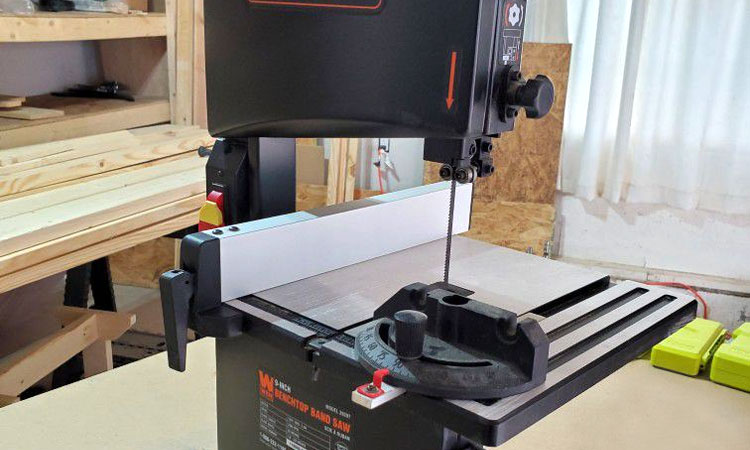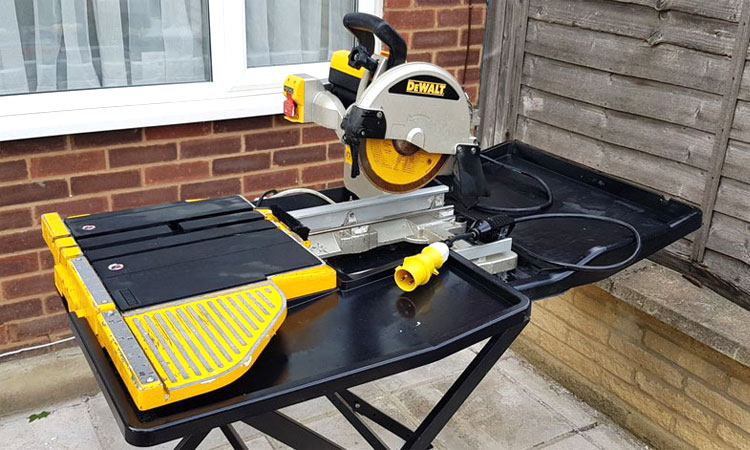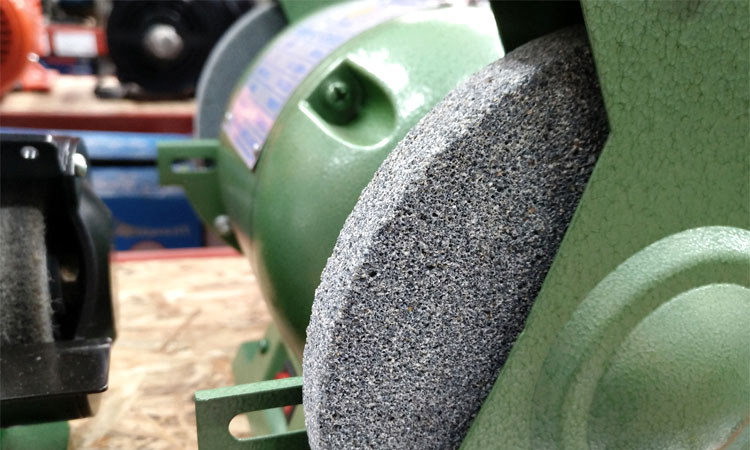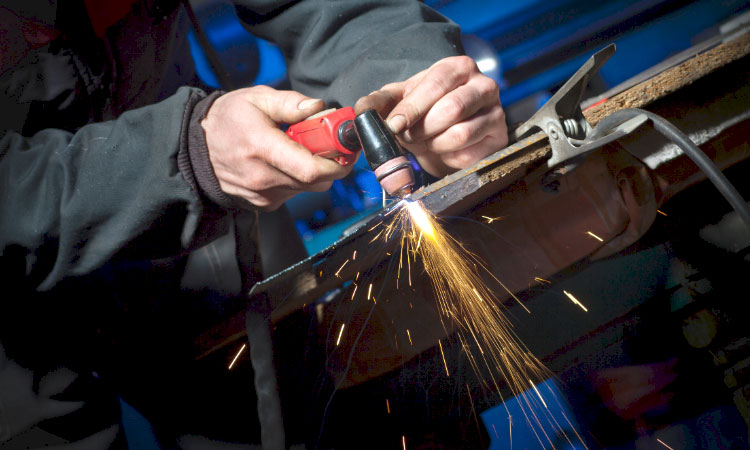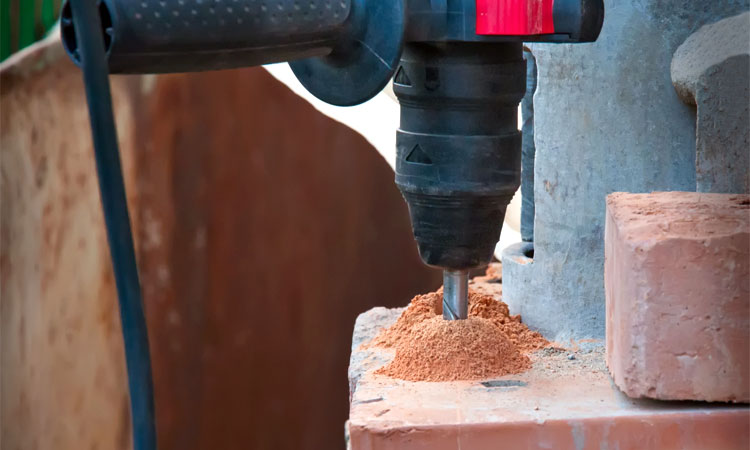9 Best Mechanic Flashlights (Small Yet Powerful)
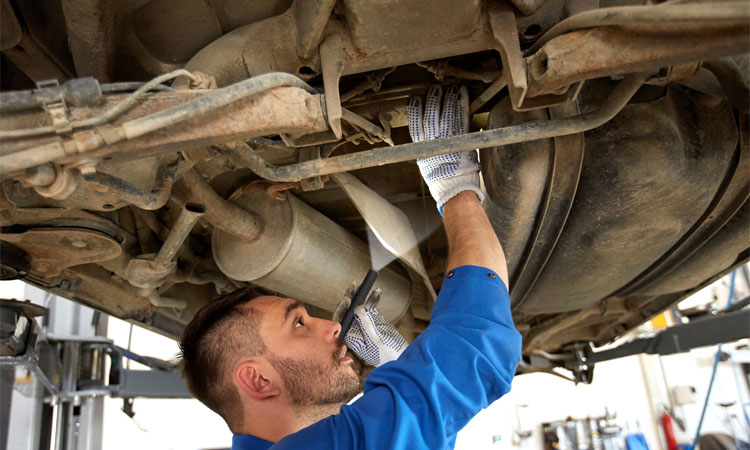
When shopping for the best flashlight for mechanics, the trend has moved away from large, clunky contraptions such as a Maglite, to smaller devices that easily fit in your pocket.
LED flashlights use less power, so you won’t be weighed down by the batteries. But they also provide bright light that can be focused on a specific area instead of illuminating a large area like a shop light does.
Whether you’re laying on your creeper under the car, inspecting the exhaust system when your car’s on a garage lift, looking for a lost screw in your engine bay, or working with wiring under the dash, a small, portable light source is a necessity.
While there are hundreds of small flashlight models out there, we’ve narrowed it down to the nine best according to what professional and home mechanics use in their garages.
Our 9 Favorite Mechanics Flashlights
| Product | Max Bright. | Batteries | Length | Diameter | Weight | |
|---|---|---|---|---|---|---|
| Streamlight ProTac | 250 LM | 2xAA | 6.1" | 0.65" | 3.4 oz | |
| Streamlight Stinger | 800 LM | rechargeable | 8.4" | 1.17" | 12.4 oz | |
| Coast XPH30R | 1000 LM | rechargeable | n/a | n/a | 8.0 oz | |
| Fenix LD22 G2 | 300 LM | 2xAA | 6.1" | 0.80" | 2.5 oz | |
| Streamlight Stylus Pro | 100 LM | 2xAAA | 5.3" | 0.60" | 1.6 oz | |
| Olight I3T EOS | 180 LM | 1xAAA | 3.5" | 0.59" | 1.4 oz | |
| Anker Bolder | 120 LM | rechargeable | 6.0" | 0.57" | 2.7 oz | |
| Coast G20 | 54 LM | 2xAAA | 5.7" | 0.63" | 2.3 oz | |
| Slonik SLNK-HEAD-5W-1 | 500 LM | rechargeable | n/a | n/a | 4.1 oz |
Mechanics Flashlight Reviews
#1 – Streamlight ProTac 88033 Tactical Flashlight
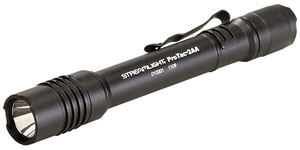
We decided on the ProTac for many reasons. It’s only slightly bigger than a true pen light but twice the brightness and a heavier duty case, this Streamlight looks to be the perfect all-around mechanics flashlight.
A true weapon against darkness, the ProTac is capable of a 250 lumen bright light for 2 hours with a 426-foot range. A lower setting provides 18 lumens of light over a 131-foot distance for as long as 43 hours. The multi-function tail switch quickly switches between high and low modes, as well as a strobe mode that can last up to four hours.
At only six inches long and powered by two AA batteries, this sturdy 6000 series aircraft aluminum tool comes with a removable pocket clip, holster, and anti-roll head. The C4 LED is impervious to shock and will provide light for 50,000 hours. Best of all, it’s rated waterproof to a depth of three feet for 30 minutes.
There’s not much that needs to be said about this flashlight, other than it’s rugged and bright. The lighter weight and long battery life make this one of the better flashlights out there, while the holster and clip are perfect for mechanics who have their hands full.
Despite this being a generally great flashlight, there have been several issues with the rear cap. A couple consumers have noted it doesn’t seal properly, which can cause the batteries to corrode and the switch to begin malfunctioning. Additionally, the switch is designed to only stay on if you push it until it clicks, often leading users to believe the flashlight won’t stay on.
>> Check price on Amazon.com <<
>> Check price on HomeDepot.com <<
#2 – Streamlight Stinger 75429 LED Rechargeable Flashlight
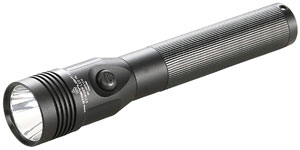
This anodized aluminum flashlight has a rubberized grip and three light modes, as well as a strobe mode. The highest setting provides 800 lumens over an impressive 1,017 feet for up to 1 ½ hours.
At the medium setting, this is reduced to 400 lumens at a still impressive 718-foot distance for 2 ½ hours. On its lowest setting, it will provide 200 lumens at a distance of 508 feet for up to five hours. The strobe will last for up to three hours.
The C4 LED will last for 50,000 hours of runtime and is shock-proof. A rechargeable 3-cell 3.6v Ni-MH sub-C battery will allow for recharging up to 1,000 times using a separate docking charger. Alternatively, the flashlight is compatible with NiCd batteries.
The amount of light this small flashlight puts out is no joke. It’s a perfect size for mechanics and will handle both chemicals and multiple drops without a problem. In fact, the only real issue with this flashlight is that the charger is sold separately. Be aware that some third-party sellers have been known to sell repackaged units instead of new ones.
>> Check current price <<
#3 – Coast XPH30R Dual Power Rechargeable LED Headlamp
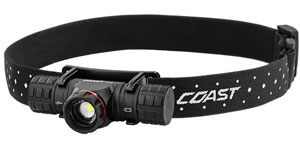
The XPH30R has a sturdy aluminum construction that’s both weatherproof and dust-resistant. Its two powerful beams focus without halos or hot spots, providing a 1,000 lumen turbo mode reaching 541 feet.
The “high” mode gives you 490 lumens for up to 7 ¾ hours. Meanwhile, at the lowest of its three intensity settings, the beam provides 40 lumens for a 101-foot distance with up to 41 hours of runtime on a single charge.
The twist focus gives you superior control, while the headlamp body has a magnetic base, allowing you to remove it and attach it to metallic surfaces for even better visibility.
The headlamp comes with a zithion-X rechargeable battery, but is also compatible with CR123 batteries. Finally, the headlamp has 3-foot drop protection, water-resistance, and is backed by a manufacturer’s lifetime warranty against defects.
Perhaps the single biggest draw of this headlamp is its ability to be used as a handheld flashlight or be mounted on metallic surfaces (like the underside of your vehicle’s hood). It’s easy to swap out the batteries when recharging the included one, and the entire lamp assembly is quite sturdy.
Note, however, that the headlamp is not fully compatible with standard USB-C cable tips, causing many consumers to believe the charging port is broken when using a cable from other devices. This is common in many devices, where the tip is either longer or shorter for a better connection.
>> Check price on Amazon.com <<
>> Check price on HomeDepot.com <<
#4 – Fenix LD22 G2 LED Flashlight
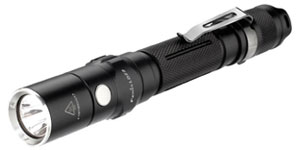
It has four distinct power levels plus a strobe and SOS function. At 100 lumens (a good output for automotive work), you can expect about 5 hours of runtime from standard alkaline batteries.
The LD22 is made out of aircraft grade aluminum and measures just over 6 inches long with a 0.6″ barrel diameter. Excluding batteries, it weighs a mere 2.5 ounces.
The main on/off button works well and remembers the last setting you used so you don’t need to unnecessarily cycle through the different brightness levels. A separate “mode” button on the side of the flashlight allows you to cycle through.
This is a great little flashlight whether working on your car or going camping. You’ll notice the difference in quality immediately when comparing to cheaper models. Comes with batteries, holster, lanyard, and even a couple spare O-rings.
>> Check current price <<
#5 – Streamlight 66118 Stylus Pro Pen Light
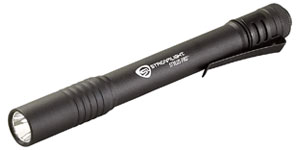
Only slightly larger than a marking pen, the Stylus Pro is small enough to take anywhere, and with a maximum output of 100 lumens it will provide plenty of nighttime visibility or illuminate dark spaces under your car or inside a cabinet.
It comes with one set of 2 AAA batteries, and each battery change will provide up to 8 hours of continuous use. It uses innovative technology to control the output, which makes the batteries last longer and provides a more dependable beam of light.
On the other hand, this handy light is longer than necessary, so carrying it in your back pocket is risky since the end of the light or the nylon case could catch on corners and cause you to lose the light. It is not as tough as you might expect, and falling from a height of a couple of feet could potentially damage the light or the switch.
With care and reasonable handling, it’s an incredibly useful flashlight for working on cars or around the house, even considering the minor complaints that are associated with it. The Stylus Pro is one of the most popular compact flashlights for mechanics and contractors.
>> Check price on Amazon.com <<
>> Check price on HomeDepot.com <<
#6 – Olight I3T EOS EDC Flashlight
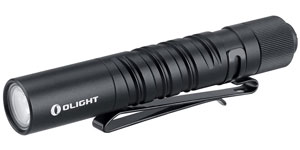
A single AAA battery is all you need to get 180 lumens for up to 21 minutes or a five lumen beam for up to 16 hours. The lightweight aluminum body has double helix body knurling to ensure a solid grip and is water-resistant enough to use in heavy rains. At a mere 1.4 ounces, it’s the lightest flashlight on our list.
The LED is paired with a TIR optic lens for a softer, more evenly distributed beam. A dual-direction pocket clip allows you to attach the light almost anywhere for more convenience.
The biggest negative is the short runtime. However, you can make it last a lot longer than advertised by using a quality rechargeable AAA battery instead of a standard alkaline. It has a very solid design and works when you need it to. Be aware, the tail switch design works well, but some users have had trouble getting used to the slight delay and method required to activate the two settings.
>> Check current price <<
#7 – Anker Bolder P2 LED Penlight
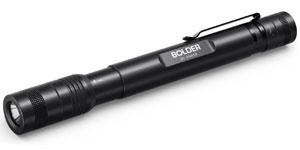
The two intensity modes (120 lumens and 40 lumens) are further fueled by an LED with 50,000 hours of life. Its durable aluminum body stands up to rough handling and is water-resistant enough to function in heavy rains, as well as a cold resistance down to a frigid 14 degrees.
This penlight isn’t the smallest on the market but its barrel diameter is a mere 0.57″ so it fits easily into a shirt or pants pocket. However, it puts out plenty of light for its size. While the design is great overall, many owners have pined over the lack of adjustable focus, as well as the need to turn the light on and off to switch between modes.
>> Check current price <<
#8 – Coast G20 Inspection Beam LED Penlight
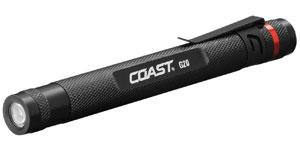
There are a lot of mixed feelings regarding this penlight, with a large percentage pointing out its usefulness when performing inspections or in emergencies. Others have noted it can take several drops without an issue.
However, there have also been several complaints that the switch has failed over time. Whether this is due to environmental conditions or a defect is unknown. A few have also noted its ability to remain on or off can be affected over time.
Don’t expect the brightness of other flashlights but when you need a clean, consistent beam of light for precision work such as inspections, the Coast G20 is one of the best values out there.
>> Check price at Amazon.com <<
>> Check price at HomeDepot.com <<
#9 – Slonik SLNK-HEAD-5W-1 Headlamp
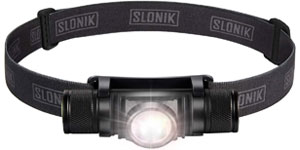
This waterproof and dustproof headlamp is made of aero-grade aluminum and nylon to ensure maximum durability and has a good amount of features for the money.
A single button lets you cycle the 300-foot, 500 lumen beam’s intensity to 100, 75, 50, 25, 10, or 5 percent. You can swivel the headlamp up and down in a 90-degree arc or detach it for handheld use.
Depending on the mode, its 2200 mAh battery can last from 3 ½ to eight hours on a single charge. Plug it in anywhere to recharge in only two hours. The American CREE XLamp XP-G2 LEDs have a lifespan of 100,000 hours, and the headlamp is covered by a 48-month warranty.
The lamp itself is quite durable and rugged, although the plastic clips are known to be more fragile. It’s also quite bright, but suffers from the same cycling issue as similar headlamps, complete with the lack of a setting memory. Of course, this is more of a nuisance than a major problem as long as you’re not looking at someone when you turn it on.
>> Check current price <<
Nebo 5618 Work Light (No Longer Available)
The Nebo work light is slightly fatter and longer than its smaller sibling, mostly because it uses 3 AAA batteries instead of one or two.
The extra battery power means you will be able to get a sustained 60 lumens of brightness for a much longer period, and that is good news for campers, A/C technicians, and anyone who is constantly performing tasks inside a darkened room or space.
As a general purpose light, this is one of the best mechanics flashlights you can get, and it casts a broader beam than you might expect from such a small profile.
The magnetic clip is not as powerful as it could be, but it will hold the light in place as long as the surface it is attached to is stable and doesn’t rattle or shake while you are working. The On/Off switch seems a little stiff, but it can be operated with your thumb and does not wiggle even after months of usage.
Choosing the Best Mechanics Flashlight
Mechanics have to deal with several factors that the average person doesn’t, meaning it can be a bit more complicated to find the right flashlight for the job.
Luckily, this also means the many different factors you’ll have to look at give a lot of leeway for personal needs. Here’s a breakdown of the most important factors and what to aim for.
Flashlight vs Headlamp
The first question you should ask yourself is whether a headlamp or flashlight is better suited for your needs.
Headlamps have a major advantage when you need both hands free. Many modern ones are detachable so you can also use them as a handheld light. The disadvantages of these lights are that they aren’t very good at aiming the light in different angles and their width means they’re not very useful for backlighting a tight space.
Flashlights are in many ways the exact opposite. The light emits from the end of the flashlight instead of the middle, so they can fit into much tighter spaces. Unfortunately, they’ll usually require at least one hand to hold them unless you attach them to your body, which can be awkward.
When choosing, think about the spaces you’ll be working in most. If you do a lot of work under vehicles where line of sight is the focus, a headlamp is your best bet. But when working with complex machines where you need to work with fasteners buried deep in the structure, a pen flashlight is the perfect tool.
Battery Type
While this might seem like a fairly minor factor, it can become quite important. For example, you’re far more likely to have some spare AAA batteries or even rechargeables on-hand than CR123, so this gives standard battery types an edge.
However, the flip side to this is that a AAA battery will have a shorter lifespan than a CR123, so you’ll want to weigh these two facts and decide which battery type will be the most useful for your needs.
Another factor is whether or not the flashlight uses rechargeables. Rechargeable batteries can save you a lot of money in the long run, but you’ll want at least one replacement on-hand so you can keep working while a battery’s charging. Most modern rechargeable flashlights have USB ports, meaning you don’t need a separate charger to bring them back up to power.
Overall, the best option out there is to get a flashlight that uses rechargeables but is also compatible with standard batteries without the need for an external charger, such as the Coast XPH30R above.
Beam Distance
While normally a major factor, this is a little less important for most mechanics. When working on a vehicle, for example, you only need to be able to see a short distance away. However, mechanics who work with exceptionally large machines such as aircraft may need a much longer range for their work.
There’s also another factor which must be considered in regards to distance. The maximum range of a flashlight isn’t the same as the optimum defined area, which is much shorter.
The Coast G20 is a great example of this, with a defined range of 30 feet but overall visibility of more than double that distance. In other words, consider the range of a flashlight and divide that number by two to get a better idea of how far you’ll see things clearly.
Durability
For a mechanic, durability can mean everything. A good flashlight should be resistant to dust and water. Shock resistance is also important, as the flashlight will likely get knocked about while on the job.
Most lights are made of high-quality aluminum, but remember that any clips are likely of cheaper metals or even plastic.
Exterior Color
Normally, this is literally a cosmetic detail, but the color can be important for a mechanic. While black is a tried and true color for a flashlight, it’s also easier to lose while working under a vehicle or other dark space if you drop it.
If possible, look for brighter colors that will make the flashlight easier to locate if dropped. True, these will show dirt more readily, but they can save you a lot of time when looking for them.
Lumens
The rating in lumens directly signifies how bright the light will be. A flashlight with a high lumen value is great for seeing over distances but can be blinding when looking at a reflective surface close-up.
Likewise, a light that has fewer lumens can be perfect for working in close quarters but will be less useful if you need to see a long way off. Most mechanics prefer a light somewhere in the 100 to 300 lumens range.
Modes
These days, flashlights do far more than turn on and off. Alight with multiple modes will allow you to use it at maximum power when needed, but can also provide a smaller degree of light in exchange for longer battery life. Many lights also have a strobe option, although this is more for self-defense and emergency use and not as useful for the average mechanic.
You may also wish to consider how these modes are achieved. Most flashlights change modes by flipping the power switch on and off repeatedly instead of having multiple stops on the switch or multiple switches. This makes it more difficult to accidentally change modes, but can be a little more annoying, especially if the light lacks a settings memory (which, unfortunately, most do).
If possible, go with a model that has a separate “mode” button and saves the last setting you used.
The number of modes is a matter of personal choice, but you should aim for a light that has at least a high and low setting. This will help save on battery life, while more modes mean the ability to set the right amount of light for any given task.
Pocket Clip
There are three kinds of clips you’re likely to find on a light. Headlamps with a detachable light use clips to hold the light on, usually made of plastic or a cheaper metal. Most flashlights will have a belt clip that may or may not be adjustable. But when it comes to penlights, the smallest of flashlights, they often lack any type of clip.
As penlights are small enough to fit in your pocket, manufacturers don’t often include a clip or design it to hang off of a keychain (for the smallest models). But for a mechanic, you should only buy a penlight if it comes with a pocket clip.
This clip (often detachable) can be a godsend when you’re laying on a mechanics creeper under a car, since your pockets are angled down in such a way that an unsecured penlight could easily fall out and roll away.
Size
This is another important factor for mechanics. You want something small but functional. Avoid any flashlight big enough to use as a deadly weapon (think of the old-fashioned Maglite powered by “D” batteries), as you’ll never get that into the depths of a car engine.
Instead, headlamps or penlights work best. A penlight that is six inches or shorter can be easier to carry, but the width will be of more concern when trying to slip it into a tight space, especially if you’re also trying to worm a screwdriver or ratchet into the same space.
Weight
Finally, you should consider the light’s weight. This isn’t as important for a tiny pocket flashlight as it is for a headlamp.
Headlamps rest on your forehead attached to a band which rarely includes a top strap. As a result, a heavier lamp will want to slide down onto your face when you’re standing or leaning forward.
For flashlights, the weight will only be an issue if you expect to be holding it in one place for a long period of time. Obviously, less weight means less fatigue and the ability to work longer without needing a break.

